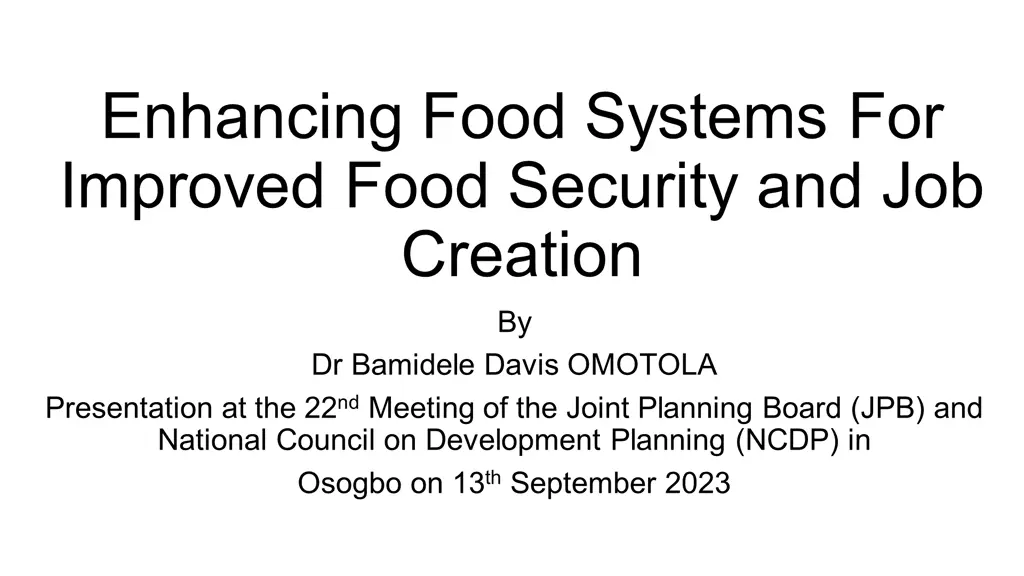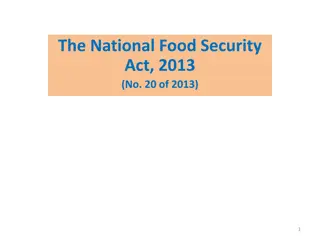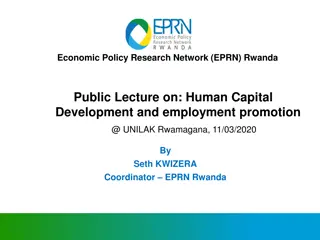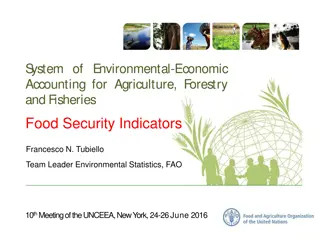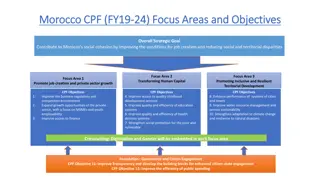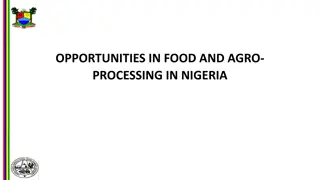Enhancing Food Systems for Improved Food Security and Job Creation
The importance of improving food systems to achieve sustainable development goals and enhance food security and job creation. It covers topics such as the current food systems, the impact of these systems, jobs in the food systems value chain, and key recommendations.
Download Presentation

Please find below an Image/Link to download the presentation.
The content on the website is provided AS IS for your information and personal use only. It may not be sold, licensed, or shared on other websites without obtaining consent from the author. Download presentation by click this link. If you encounter any issues during the download, it is possible that the publisher has removed the file from their server.
E N D
Presentation Transcript
Enhancing Food Systems For Improved Food Security and Job Creation By Dr Bamidele Davis OMOTOLA Presentation at the 22ndMeeting of the Joint Planning Board (JPB) and National Council on Development Planning (NCDP) in Osogbo on 13thSeptember 2023
Presentation Outline Introduction /Background The existing Current Food Systems The Impact of our food Systems Jobs in the Food Systems Value Chain Key Recommendations
Background None of the 17 Sustainable Development Goals (SDGs) will be achieved without improving food systems, the United Nations Secretary-General called for a Food Systems Summit in 2021. The fundamental goal of the Summit is to guide governments and other stakeholders to identify and implement reforms that would transform food systems towards achieving SDGs. The Summit is organized around five interrelated Action Tracks, and four levers of change (human rights, finance, innovation, and empowerment of women and young people) that cut across the 5 Action Tracks.
The Five Action Tracks of the Summit Action Track 1 Ensure access to safe and nutritious food for all Action Track 2 Shift to healthy and sustainable consumption patterns Action Track 3 Boost nature-positive food production at scale Action Track 4 Advance equitable livelihoods and value distribution Action Track 5 Build Resilience to vulnerabilities, shocks, and stresses
Introduction Introduction The food systems touch every aspect of human existence - affects the health of our bodies, as well as the health of our environment, our economies and our cultures. Many people earn their living from the food systems. Current food systems are not all functioning well and beset by complex multiple challenges. Identified game changing ideas are to help transform the food system of various subpopulations within the country. This align to global game changing ideas so that future efforts can bring countries together around action areas and solution clusters derived
What is Food system? What is Food system? Food systems encompasses all the elements and activities involve in: Production, processing, distribution, preparation and consumption and wastage of food Actors/stakeholders and output of these activities including socio- economic and environmental outcomes. Every person and process involved in growing, raising or making food, right through to consumption and what we do with our waste. Infrastructure involved in growing, harvesting, processing, packaging, transporting, marketing, consumption, distribution and disposal of food and food-related items. The system provide a framework to advance access to safe and nutritious food for all
Characteristics of the Nigerian Food Systems
Poverty is high with more than 40% of Nigerians living in households that spend less than 137,430 per person per year; and poverty is directly correlated with agricultural employment As the percent of men engaged in farm employment increases at state level, the poverty rate appears to also increase. This relationship reflects failures and inefficiencies in the entire national food systems.
Available food is not affordable 33% of Nigeria s population cannot afford a diet that provides enough energy 72% cannot afford a diet that contains all essential nutrients 91% cannot afford healthy diets that meet all food consumption recommendations FAO, IFAD, UNICEF, WFP and WHO. 2020
Diets are poor and malnutrition is at alarming levels Diets are poor and malnutrition is at alarming levels 80% Just 11% of young children 68% 70% were fed the minimum 58% 56% 60% acceptable diet in 2018, and 50% 37% only a little over half of the 40% 30% women of reproductive age 20% 11% consumed foods that met 7% 10% minimum dietary diversity. 0% Minimum acceptable diets in young children Minimum dietary diversity in women 15 to 49 years old Stunting (chronic malnutrition in children under 5 years) Wasting (acute malnutrition in children under 5 years) Anaemia in children 6 to 59 months Anaemia in women 15 to 49 years old Stunting and anaemia in women and children are at very serious levels. NDHS 2018
Malnutrition in children under 5 years is especially worrisome, because of the associated consequences for cognition, education, and future productivity and income In 2018, just 21% of children 6 months to 59 months old No stunting, wasting, overweight, or anaemia were free from all forms of nutrition-related conditions assessed. At least one nutrition-related condition 79% 79% of children had at least one nutrition-related condition, and many children .
Prevalence of diet-related noncommunicable diseases, including hypertension, diabetes, stroke, and cancers are alarming and increasing Prevalence of Adult Diabetes in Nigeria In 2015, 23% of adult males and 6.5% 6.2% 6.1% 6.0% 5.9% 25% of adult females had raised 6.0% 5.8% 5.7% blood pressure (systolic and/or 5.5% diastolic blood pressure >= 5.0% 140/90 mmHg) 4.5% 4.0% Among both female and male adults, high blood pressure is high and affects about a quarter of adults. Diabetes has been increasing steadily and 1 out of every 16 adults is diabetic. High blood pressure, diabetes, stroke, heart disease, and some cancers are all diet related and have been linked to poor food systems. 3.5% 2009 2010 2011 2012 2013 2014 Global Nutrition Report; NCD-RisC
Impact Food systems contribute a considerable part of national economy and influence many developmental issues, including hunger, malnutrition, disease, poverty, livelihoods, unemployment, conflict, violence, and climate change. Improving food systems can therefore initiate positive change for multiple challenges
Potential Impact of Sustainable Implementation of the Potential Impact of Sustainable Implementation of the Food Systems Transformation in Nigeria Food Systems Transformation in Nigeria Fight against poverty by creating good jobs, improving access to food, and supporting healthy communities. Solving long-term hunger challenges and managing acute shocks, Helps people of all ages to achieve good health Enable all students to have a healthy and balanced diet, Empower and support women and bolster their livelihoods Sustainable use of water resource, while also reducing the amount of pollution in our natural water systems. Maximize the use of clean and renewable sources of energy, Create decent jobs and support the incomes
Food Systems Value Chain Components Food Production Systems Storage and Distribution Systems Processing and Packaging Retail and Marketing
Food Production Systems Food production systems are influenced by various factors, such as climate change, population growth, consumer preferences, environmental impacts, and technological innovations. Food production systems need to adapt to these changes and challenges to ensure food security and sustainability for the present and future generations
Food Production Systems includes Conventional Commissary food systems Ready-prepared food systems Assembly serve food systems Display cooking food systems
Jobs and Food Systems Value Change The food system employs the majority of people in self and wage employment both on and off the farm. Globally, 65% of poor working adults relied on agriculture for their livelihoods in 2016. According to 2017 data, farming generates about 68 percent of rural income in Africa, and about half of rural income in South Asia. According to the World Bank, the food system is expected to provide more than 70% of total jobs in some African countries by 2025 The demand for jobs in off-farm segments of the food system, such as processing, distribution, retailing and restaurants, will also increase as incomes and eating patterns change However, millions of jobs in food production are disappearing due to climate change, urbanization and industrialization.
Jobs and Food System Value Chain 2 To enhance the food system s contribution to jobs, governments is required to promote investments in healthier and safer food value chains, ensure that policies and investments do not undermine employment intensity relative to long-term market trends, facilitate the inclusion of women and youth, and improve the quality of jobs.
Jobs and Food Systems Value chain3 Changes in diets, rising consumer demand and urbanization, supported by investments in infrastructure and rapidly evolving technology, are creating opportunities in the broader food system including in manufacturing, marketing, transportation and food preparation. In Africa, Food Systems accounts for nearly 50% of economic activities in 2013 food systems accounted for nearly 50 percent of economic activity in 2013 and could create a trillion-dollar food market and even more jobs-- by 2030
Recommendations Recommendations Implementation of the food systems transformation pathways recommendations at the sub-national level with particular focus on the agreed actions Continued support, collaboration and partnership among all stakeholders including governments at all levels (Federal, States and LGAs0; Private sector and Businesses and Development partners; CSOs and CBOs as well as Academic community :
Recommendations Develop mechanisms for aggregating produce: Small farmers need mechanisms such as producer organizations, companies or other institutions-- that aggregate their produce to reach scales that help them get better deals in markets. Make value chains more inclusive: Empower and engage with different stakeholders along the entire value chain including women and NGOs and orient it towards creating more and better jobs, and facilitating enterprises. Invest in expanding the Micro-Enterprise and Small and Medium Enterprise ecosystem: Invest in the growth of existing and emerging SMEs Engage youth through skills development, vocational education, incubation and digital agriculture: Provide youth with opportunities to develop and enhance their skills in order to help them access agripreneurship opportunities and acquire jobs in agribusiness, off-farm, non-farm, and rural labor markets. Focus should also be put on social enterprises, incubation for youth entrepreneurs and the use of ICT to create digital jobs that provide agriculture services.
